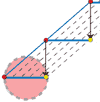 |
Migration
of Widespread Long-Lived Volcanism Across the
Galápagos Volcanic Province: Evidence
for a Broad Hotspot Melting Anomaly? |
John M. O’Connora,*, Peter Stoffersb,
Jan. R. Wijbransa & Tim J. Worthingtonb
aDepartment of Isotope
Geochemistry, Vrije University, Amsterdam, The Netherlands, john.o.connor@falw.vu.nl
bInstitute for Geosciences, Christian-Albrechts-University,
Kiel, Germany
Abstract
We present here 40Ar/39Ar
ages for many new basement samples from the Galápagos
Volcanic Province (GVP) and evaluate their implications
for the various models put forward to explain the origin
of the GVP. Correlating new and published sample site
ages with distance from the western side of the Galápagos
Islands shows that volcanism has not progressed in
narrow, time-progressive lines of seamounts and ridges
as predicted by the conventional fixed-hotspot/mantle-plume
hypothesis. Rather, volcanism apparently migrated time-progressively
across the GVP in broad regions of long-lived and possibly
concurrent volcanism. We propose that the most viable
explanation for these observations is that the GVP
is the product of Cocos and Nazca plate motions across
a broad hotspot melt anomaly. The complex spreading
history of the Cocos-Nazca spreading centre likely
controlled the relative distribution of GVP volcanism
between the Cocos and Nazca plates while creating lithosphere
of variable age/thickness across the region. While
the notion of a broad Galápagos
hotspot melting anomaly linked to a complex regional
tectonic history requires significant testing it
nevertheless highlights the need to test alternative
mantle upwelling shapes and sizes compared to the
widely accepted notion of a narrow continuous long-lived
Galápagos mantle plume conduit defined by
the size and location of a Galápagos island.
This webpage summarises our recent paper published in
Earth and Planetary Science Letters (O’Connor
et al., 2007).
1. Introduction
The well-studied Galápagos
Archipelago is a small part of the much larger Galápagos
Volcanic Province (GVP) consisting of the Cocos,
Carnegie, Coiba and Malpelo aseismic ridges and related
seamount provinces. In order to establish how well
the GVP fits with the predictions of the "standard"
fixed hotspot and mantle plume hypotheses we undertook
the first systematic dredge-TV Grab sampling of the
largely un-sampled submerged regions of the GVP (Figure
1) using the RV SONNE (Werner et
al., 2003). We report
here 40Ar/39Ar ages for SO144/3
dredge and two previously undated DSDP Leg 16 drill
samples (Werner
et al., 2000)
and evaluate their implications for the many geochemical
and geophysical models (summarised in O’Connor
et al., 2007) that have
been put forward to explain the origin of the GVP.
We show that the temporal and spatial distribution
of new and published ages is compatible with GVP
formation via time-progression of broad regions
of long-lived, and possibly concurrent, volcanism.
We propose that such observations are most consistent
with GVP formation via a process involving Cocos
and Nazca tectonic plate divergence across a very
broad Galápagos hotspot
melting anomaly.
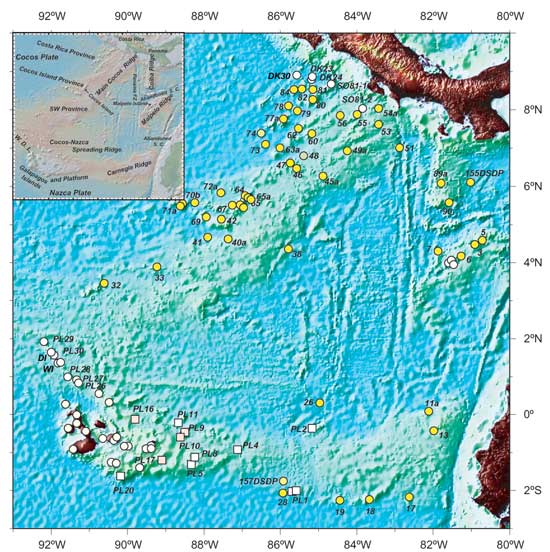
Figure 1: Ocean
floor topography (Smith & Sandwell, 1997) showing
the Galápagos
Volcanic Province (GVP). Yellow dots indicate new
sample sites (SO 144/3 Expedition) and DSDP Leg
16 sites. White dots show sample locations for
published 40Ar/39Ar dated
rock samples (Werner et al., 1999, Hoernle et al.,
2002) and K/Ar dated subaerial samples sites on
the Galápagos
Islands (White et al., 1993). White boxes show
PLUME-2 sample sites (Sinton et al., 1996). Click
here or
on figure for enlargement.
2. Results
Time-progressive GVP volcanism?
Correlating new Carnegie Ridge 40Ar/39Ar
and published Galápagos Archipelago K/Ar (White
et al., 1993)
sample site ages with distance from the western leading-edge
of the Galápagos Archipelago (active Cerro
Azul volcano, SW Isabela Island) suggests an overall
trend of time-progressive GVP volcanism on the Nazca
tectonic plate (Figure 2a). Similarly, a broad overall
trend of time-progressive GVP volcanism on the Cocos
tectonic plate is indicated in a correlation of Cocos
Ridge/seamount provinces/island sample site ages
with distance from the western edge of the Galápagos
Archipelago (Figure 2b). Combining new and published
(Werner
et al., 1999, Sinton et al., 1996, Hoernle
et al., 2002)
40Ar/39Ar ages for Cocos and
Carnegie ridges and seamounts (Figures 2c & d) reinforces
our inference that, fundamentally, volcanism migrated
across the GVP time-progressively. Evidence for volcanism
between ~17 and ~11 Ma on Malpelo and Coiba ridges
(Figure 2d) suggests that these ridges formed together
with older regions of the Cocos and Carnegie ridges
and seamounts. Malpelo and Coiba ridges have since
rifted away from Carnegie and/or Cocos ridges due
the complex spreading history of the CNS (Meschede & Barckhausen,
2001, Hoernle et al., 2002, Gahagan & Mann,
2002,
Werner et al., 2003, Sallares & Charvis,
2003,
MacMillan et al., 2004). Moreover, older
parts of the Cocos and Carnegie ridges are likely
to have been subducted (e.g., Gahagan & Mann,
2002, MacMillan
et al.,
2004).
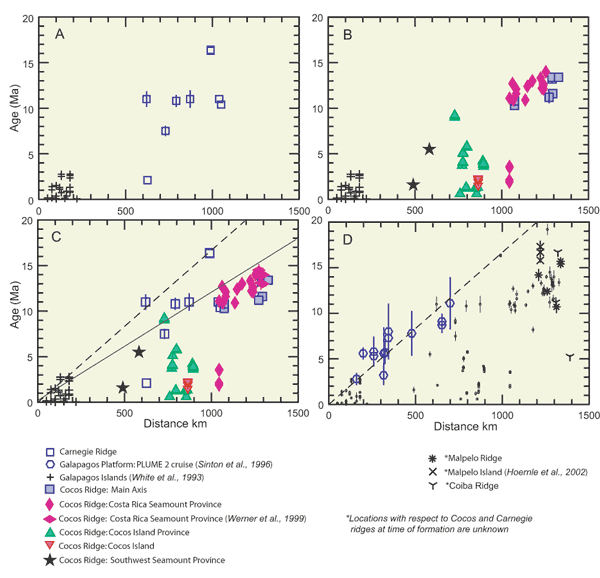
Figure 2: (A) Correlation
of new Carnegie Ridge ages with distance from the
western leading edge of the Galápagos
Archipelago. (B) Correlation of new Cocos
Ridge/Seamounts/Island ages with distance from the
western edge of the Galápagos
Archipelago. (C) Correlation of combined
Carnegie (A) and Cocos Ridge/Seamounts (B) ages with
distance from the western edge of the Galápagos
Archipelago. Also shown are published data for the
Costa Rica Seamount Province (Werner et al., 1999).
Dashed regression line is fitted to Carnegie Ridge
samples SO144/3-17TVG, DSDP 157 and oldest K/Ar ages
for the Galápagos
Islands (White et al., 1993). The solid thin line
shows broad agreement between GPS measured migration
rate of 83 ± 3 km/My for the Cocos plate with
that indicated by the age-distance correlation for
Cocos plate GVP lavas erupted closest to the western
edge of the Galápagos Archipelago. (D)
Correlation of published ages for Malpelo and Coiba
ridges (SO144/3 and DSDP 155), the Galápagos
Platform (Sinton et al., 1996) and Malpelo Island
(Hoernle et al., 2002) with distance from the western
edge of the Galápagos Archipelago. Click
here or
on figure for enlargement.
Widespread GVP volcanism
The widespread nature of GVP volcanism is evident
in a correlation of measured ages with distance and
in the geographical distribution of new and published
(Figure 1) 40Ar/39Ar
and K-Ar (Galápagos
Islands) assigned to 1 My time intervals or "bins"
(Figure 3). This observation is further supported
by existing evidence for widespread volcanism across
the Galápagos Archipelago (White
et al., 1993) and
platform (Figure 3; Sinton et al., 1996).
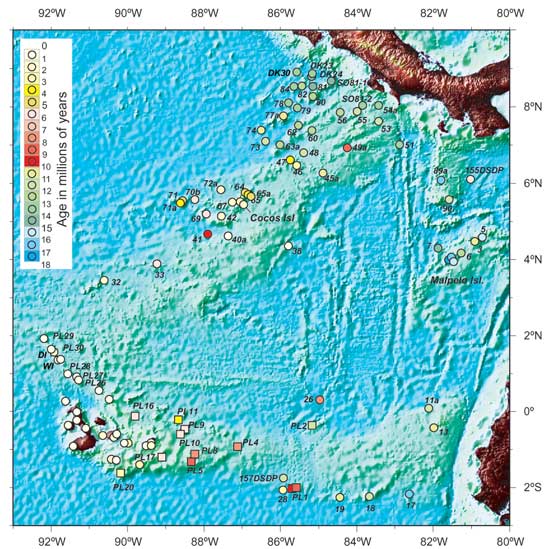
Figure 3: Geographical
distribution of new and published (Figure 1) 40Ar/39Ar
and K/Ar ages assigned to 1 My time intervals or "bins".
Colour coded intervals also suggest GVP development
via a process leading to time-progression of widespread,
long-lived and possibly synchronous volcanism.
Volcanism continued for ~6 My (except DSDP 155),
on Malpelo and Coiba ridges, ~5 My at the NE end
of Cocos Ridge (except for much younger adjacent
46TVG and 47DR sample sites), ~5 My on Carnegie
Ridge (excluding much younger 26 TVG and 28DR samples),
~5 My in the Cocos Seamount Province (except for
the much younger <2 My old
Cocos Island, 4 Cocos seamounts and 1 co-latitudinal
Cocos Ridge sample). We therefore infer a ~5 My average
for the duration of the main phase of volcanism (shield
to post-shield?) across the GVP together with rarer
post-erosional (rejuvenescent) phases linked to localised
tectonics, e.g., reactivation of small-degree Galápagos
"mantle plume melts" (Castillo et al.,
1988), late stage spreading west of Cocos Island
(Werner et al., 2003) or alkalic volcanism lasting
for several million years after a ridge jump ("post-abandonment"; Batiza & Vanko,
1985). See
text for discussion.
Long-lived GVP volcanism
Although we infer
an average of ~5 My duration for volcanism across
the GVP (Figures 2 and 3). Measured ages for the
Galápagos
Islands do not seem to support such an inference
since volcanism apparently began ~3 Ma in the eastern
part of the archipelago and has continued until <1
Ma (White et al., 1993, their Figure 5).
However, the Galápagos Islands are still
volcanically active so we cannot rule out that
volcanism will continue across the archipelago
into the future such that the final time span of
volcanism may be ultimately in the same range as
those observed for older GVP centres.
Coeval GVP volcanism?
While age data for
the GVP remains limited there is nevertheless evidence
for GVP formation via a process that leads to broad
regions of coeval volcanism (Figures 2 & 3). The
most notable observation is a 10-11 Ma region of
dispersed concurrent volcanism on both the Cocos
and Nazca tectonic plates (Figure 2). Moreover, these
coeval regions overlap in a correlation of sample
age with distance from the leading edge of the Galápagos
Archipelago Platform suggesting a ~700-m-wide region
of 10-11 Ma coeval GVP volcanism (Figures 2 & 3).
This notion of broad regions of coeval regional volcanism
is supported by evidence for recent (<1 Ma) synchronous
volcanism across the Galápagos Archipelago (Figure
3).
3. Discussion
How broad is the Galápagos "hotspot
melting anomaly"? Measured ages point to
GVP formation via a process leading to time-progression
of broad regions of long-lived, possibly coeval,
volcanism. Such a process is more compatible in our
view with the notion of a much broader Galápagos
hotspot melting anomaly (300 to 400 km) than is incorporated into current models
put forward to explain GVP origin and development (Figure 4).
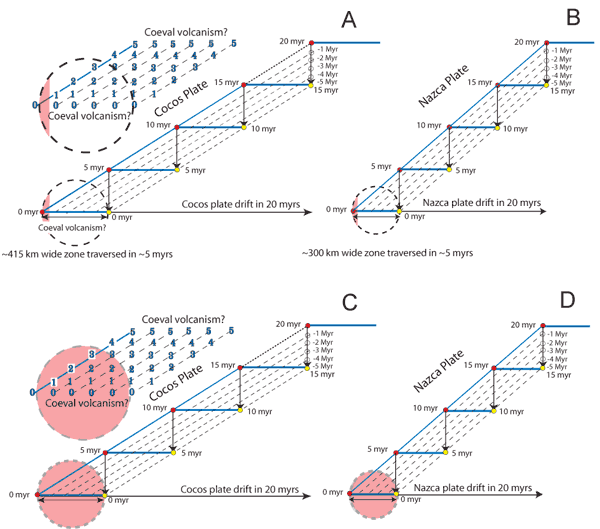
Figure 4: Cartoon
showing GVP development via the time-progression
of widespread, long-lived and possibly coeval
volcanism reflecting Cocos and Nazca plate
migration (and divergence) across a broad
Galapagos hotspot melting anomaly. Two end-member
scenarios are:
- hotspot volcanism is initiated as
the Cocos and Nazca plates pass across
the leading edge of a broad anomaly
and continues until the affected region
has drifted downstream beyond the influence
of the anomaly (panels A and B), and
- GVP volcanism is initiated across
the anomaly and continues (randomly or
episodically) as the Cocos and Nazca
plates migrate across the anomaly (panels
C and D). See text for further discussion.
Scenario 1: (A)
Cocos Plate: A hypothetical
age-distance correlation for GVP volcanism
initiated at the leading edge of a broad
hotspot melting anomaly. Volcanism continues
for ~5 Ma as the Cocos plate migrates across
the
"melting zone" at a rate of ~81
mm/yr. The melting anomaly diameter of
~400 km is inferred from a Cocos plate velocity
of ~81 mm/yr and an average of ~5 Ma of volcanism
at any particular locality across the GVP
(Figure 2). The 0-5 Ma insert illustrates
the development of coeval lines of dispersed
volcanism orientated in the direction of
plate motion and corresponding in size to
the width of the melting anomaly (numbers
represent millions of years since the lava
cooled). Long solid line reflects age-distance
correlation for initially erupted lavas. Long
dashed sub-parallel lines illustrate age-distance
correlation for lavas formed in million-year
increments after initial volcanism. Short
solid blue lines show time-progression of
coeval lines and their proposed time-progression
across the GVP. (B) Nazca
Plate: Shows
the corresponding age-distance correlation
for GVP volcanism on the Nazca plate. The
slower Nazca plate drift of ~60 mm/yr suggests
a narrower ~300-km-wide melting anomaly leading
to correspondingly shorter lines of coeval
volcanism. Other details as in A.
Scenario 2: Volcanism initiated
across a broad hotspot melting anomaly.
(C) Cocos Plate: Cartoon showing GVP
formation by ongoing volcanism (random or
episodic) across a broad Galápagos
hotspot melting anomaly. Other details as
in (A). (D) Nazca Plate: Shows the
corresponding model in the case of the Nazca
tectonic plate. Other details as in B. |
Both scenarios predict
similar GVP spatial and temporal development, and
are compatible with our observation that the volcanism
is:
- broadly time-progressive,
- widespread,
- long-lived (we infer an ~5 Ma average lifespan),
and
- possibly formed in bands of coeval volcanism
orientated in the direction of Cocos and Nazca
plate motions, respectively (Figure 4).
Since both
end-member possibilities lead to indistinguishable
patterns of widespread, long-lived and possibly
coeval volcanism it is not possible, from our data,
to determine which might be the dominant mechanism
or whether interplay between both is involved. Future
studies aimed at distinguishing between these two
end-members are important in our view.
Scenario 1 is more compatible with current
models requiring a focus of upwelling at the leading
edge of the hotspot (e.g., a narrow plume
conduit). Scenario 2 involves initiation of volcanism
across the anomaly so suggesting the need to propose
and test a range of possible mantle upwelling
(plume?) shapes, sizes and dynamics.
4. Conclusions
New and published
isotopic basement ages suggest that the GVP formed
via a process leading to time-progression of broad
regions of long-lived and possibly concurrent zones
of volcanism. We infer an average of ~5 Ma of shield
to post-shield volcanism across the GVP together
with much rarer occurrences of significantly later
post-erosional (rejuvenated) volcanism linked to localised tectonic control.
Moreover, our inferred migration rates for GVP volcanism on the Cocos and Nazca
tectonic plates, although poorly constrained nevertheless seem to correspond
with their respective GPS-measured present-day relative plate velocities. We
conclude that the complex history and distribution of GVP volcanism might be
explained by Nazca and Cocos tectonic plate divergence/migration across a broad
hotspot melting anomaly on the order of 300-400 km wide.
The distribution of GVP isotopic ages is equally
well explained by
- onset of volcanism at the leading
edge of a broad hotspot melting anomaly, and
- random or episodic volcanism across a broad
anomaly.
Both end-member scenarios predict long-lived
(~5 Ma) volcanism across the GVP reflecting the
time taken for the Nazca and Cocos plates to drift
across hotspot. While both scenarios require a
broad Galápagos
melting anomaly it is not possible to establish
which might be the dominant mechanism. Distinguishing
between these end-member possibilities is important
since in our view Scenario 1 - onset
of volcanism at the leading edge of such a melting
anomaly - is a more passive process that fits better
with formation of the GVP by a narrow deep-seated
continuous plume "tail" or "conduit"’ at
the western leading edge of the Galápagos
Archipelago platform. Such a posited mantle plume
conduit is thought to be tilted by shear in the
upper mantle due to (Nazca) plate motion and upper
mantle flow. Thus, widespread long-lived volcanism
across the Galápagos Archipelago and underlying
platform has been attributed to long-lived melting
downstream from the leading edge of the Galápagos
hotspot (i.e., "plume conduit")
or "post-shield
extensional volcanism" across the platform
region at earlier formed shield volcanoes (White
et al., 1993, Sinton
et al., 1996). Both of these
mechanisms require the existence of narrow mantle
plume "conduit" or "tail" at
the leading western edge of the Galápagos
archipelago on the scale of a single island (e.g.,
Isabela Island).
In contrast, Scenario 2 -
random or episodic volcanism across the anomaly
- does not require a narrow focused upwelling anomaly
(plume conduit). Our notion of a broad Galápagos
hotspot melting anomaly therefore opens the way
to testing a greater range of possible mantle upwelling
(plume?) shapes, sizes and dynamics (e.g.,
thermo-compositional?) via, for example, combined
dredge-, ROV- and drill-sampling and tomography,
seismic and numerical studies.
References
-
Batiza, R. and D.A. Vanko, Petrologic
evolution of large failed rifts in the eastern
Pacific: petrology of volcanic and plutonic rocks
from the Mathematician ridge area and the Guadalupe
trough, Journal
of Petrology 26,
564–602, 1985.
-
Castillo, P.R., R. Batiza,
D. Vanko, E. Malavassi, J. Barquero and E. Fernandez,
Anomalously young volcanoes on old hotspot traces:
I. Geology and Petrology, Geol.
Soc. Am. Bull. 100,
1400–1414, 1988.
-
Gahagan, L. and P. Mann, Monkey
Wrench in the Central American Subduction Factory:
Improved Age Estimates for the Subduction History
of the Cocos Ridge, Eos
Trans. AGU 83(47),
Fall Meet. Suppl., Abstract T52B-1205, 2002 .
-
Hoernle, K.A., P. vd Bogaard,
R. Werner, B. Lissinna, F. Hauff, Missing history
(16–71
Ma) of the Galápagos
hotspot: Implications for the tectonic and biological
evolution of the Americas, Geology 30,
795–798, 2002.
-
MacMillan,
P.B. Gans and G. Alvarado, Middle Miocene to present
plate tectonic history of the southern Central
America Volcanic Arc, Tectonophysics 392,)
325–348, 2004.
-
Meschede, M., and U. Barckhausen,
The age of submarine ridges in the eastern Panama
basin: Constraints from paleogeographic restorations, Int.
J. Earth Sci., 90,
386–392, 2001.
-
-
-
Sinton, C.W., D.M. Christie
and R.A. Duncan, Geochronology of Galápagos
seamounts, J.
Geophys. Res., 101,
13,689-13,700, 1996.
-
Smith, W.H.F. and D.T. Sandwell,
Global seafloor topography from satellite altimetry
and ship deep soundings, Science 277,
1956–1962, 1997.
-
Werner, R., K.A. Hoernle, P.
van den Bogaard, C. Ranero, R. von Huene and D.
Korich, A drowned 14-m.y.-old Galápagos
Archipelago off the coast of Costa Rica: Implications
for tectonic and evolutionary models, Geology 27 ,
499–502, 1997.
-
Werner, R., D. Ackermand, T.
Worthington and Shipboard Scientific Party, Cruise
Report Sonne 144-3 PAGANINI 3 Panama Basin and
Galápagos “Plume” – New
Investigations of Intraplate Magmatism Puerto Caldera,
Costa Rica - Balboa, Panama 9. November - 18. Dezember
1999, 177 Christian-Albrechts-Univ., Kiel, 2000.
-
Werner, R., K. Hoernle, U. Barkckhausen
and F. Hauff, Geodynamic evolution of the Galápagos
hot spot system (Central East Pacific) over the
past 20 m.y.. Constraints from morphology, geochemistry,
and magnetic anomalies, Geochem. Geophys. Geosyst. 4(12)
1108, doi:10.1029/2003GC000576, 2003.
-
White, W.M., A.R. McBirney and
R.A. Duncan, Petrology and geochemistry of the
Galápagos
Islands: Portrait of a pathological mantle plume, J.
Geophys. Res., 98,
19,533–19,563, 1993.
last updated 8th
January, 2008 |
